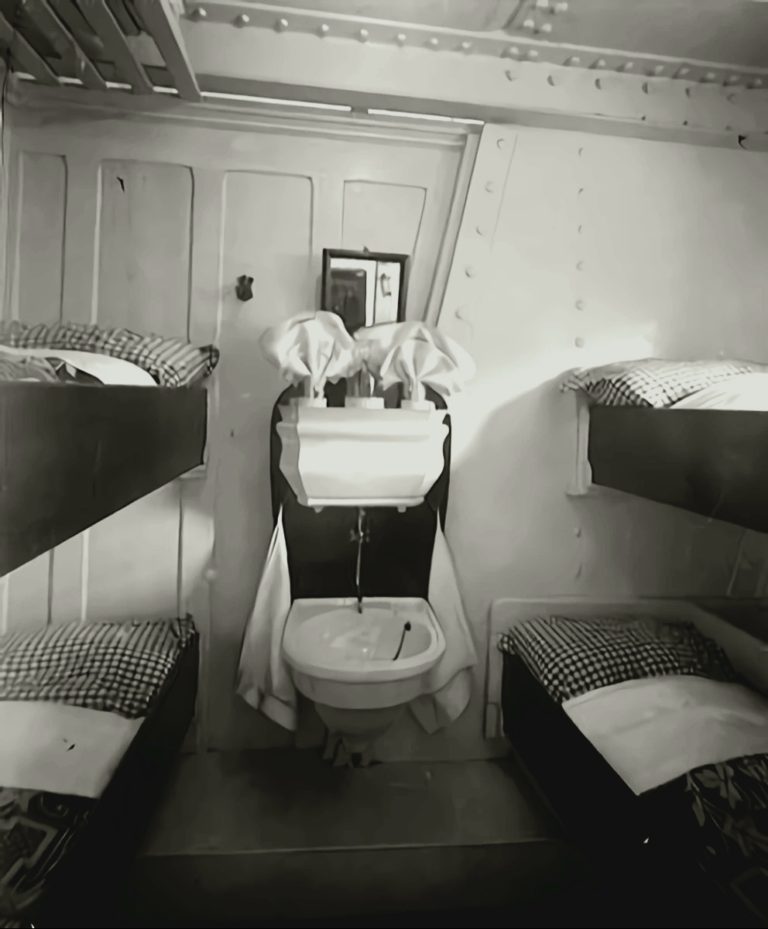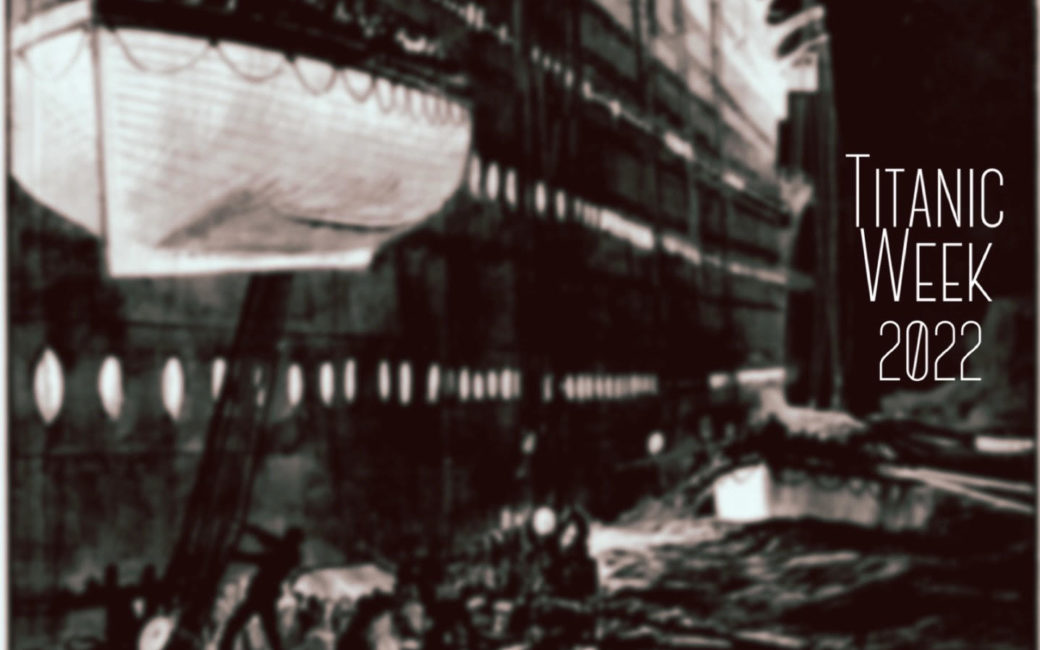"Locker 14, F Deck": Sidney Sedunary
Samuel “Sidney” Sedunary signed onto Titanic on April 4, 1912. He hailed from Berkshire, England, and was the eldest of 7 children.
Sidney was assigned as a Second Steward in Third Class. He had only recently been married to his sweetheart, Madge Tizzard, in late 1911. He was 25 years old; she, 24.
And by the time he boarded Titanic, Madge was pregnant.
Even though he was comparatively young at the time of his assignment, but he’d already had 8 years of experience at sea. In April of 1904, at just age 17, Sidney joined the Royal Navy. His record indicates that he was acknowledged for excellent conduct; his appearance is also noted with brown hair, brown eyes, and a tan complexion.
After 1908, Sidney moved to the private sector, serving on the Adriatic, and then on Titanic’s elder, and practically identical, sister, the RMS Olympic.

A promotional postcard distributed by the White Star Line to advertise the quality of Third-Class accommodations in the Olympic class.
As the Second Steward in Third Class, Sidney was required to support the Chief Steward, a man named James W. Kieran.
Most stewards were roomed en masse on F Deck. But Sidney was gifted with a E-Deck cabin shared with only one other crew member: Ludwig Muller, the sole translator hired for the entirety of Third-Class passengers.

A Third-Class passenger cabin on the RMS Olympic, circa 1911 or 1912.
There is comparatively little information regarding the circumstances of Third Class on the night of the sinking. Much of what is known is ascribed to the testimony of John Hart, one of the eight surviving Third-Class Stewards.
Third-Class evacuation during the sinking was inevitable bedlam. With multiple languages and a single ship translator, confusion was rampant. But it wasn’t just that. Many passengers, even in Third Class, were adamant that it was safer to stay on the ship. John Hart testified that many of the 59 people in his charge “refused to put [lifebelts] on… they said they saw no occasion for putting them on; they did not believe the ship was hurt in any way.”
John Hart continued.
Some of them went to the boat deck, and found it rather cold, and saw the boats being lowered away, and thought themselves more secure on the ship, and consequently returned to their cabin… I heard two or three say they preferred to remain on the ship than be tossed about on the water like a cockle shell.
During the British Board of Trade Inquiry cited above, John Hart testified to witnessing Sidney working with his superior mid-sinking. (Please do note that Sidney's surname is transcribed phonetically as "Sedginary").
I waited about there with my own people trying to show them that the vessel was not hurt to any extent to my own knowledge, and waited for the chief third class steward, or some other Officer, or somebody in authority to come down and give further orders. Mr. Kieran [id est, the Chief Steward] came back. He had been to sections S, and Q, and R to see that those people also were provided with lifebelts… he had also his assistant with him, one by name, Sedginary. [Sidney Sedunary.]
Immediately thereafter, when asked again, Hart repeated that Sidney had been assisting James Kiernan in distributing lifebelts.
What about the assistant; you say his assistant was with him?
- Yes.
John Hart estimated that he received his initial orders to get lifeboats on his passengers after “three parts of hour” after the iceberg strike at 11:40pm, so he believed it was about 12:30pm. He came across Sidney and Chief Steward James Kieran sometime after that, after they had been to Section S, Q, and R, which were toward the stern and split between three decks: S on G Deck, R on F Deck, Q on E Deck.
G Deck had started to flood at 11:55pm. The forward section F Deck saw water by 12:05am; forward E Deck, around 12:10am, along with water traveling down Scotland Road—the well-known but rarely-named ship-long hallway.
The Chief Steward had to instruct all the other Third-Class stewards throughout the ship. While those stewards receiving instruction were ferrying people in groups up to boat deck—John Hart testified to having taken two or three trips up—the Chief Steward and his assistant were completely embroiled in managing directions on G, F, and E Decks.

The Third-Class General Room, as depicted in a promotional illustration by the White Star Line to advertise Third-Class accommodations in the Olympic class.
Inevitably, since Sidney was in the company of James Kieran or otherwise transmitting his orders to lower Stewards, he presumably moved between the forward (bow) and aft (stern) sections on E, F, and G Decks—which were already flooding to variable degrees.
Segregated in the depths of the ship and at points likely wading through frigid seawater as he acted as Kieran’s right-hand man, Sidney had to have known how frail his chances of survival truly were.
But even as he watched others—colleagues and passengers—move to the upper decks and back again, Sidney was dedicated in his duties as the ship foundered.
As far as we can deduce from the evidence, he spent the majority of the sinking down below, unlocking cupboards and distributing lifebelts instead of seeking a lifeboat.

A Third-Class Stairwell on C-Deck on the RMS Olympic, circa 1911. Courtesy of Bedford Lemere & Co.
Sidney Sedunary likely did get up to boat deck. Only once it was too late.
And after the exhaustion and adrenaline of the evacuation, he could not survive the cold.
His corpse was the 178th recovered by the crew of the Mackay-Bennett, and was noted thusly.
NO. 178. - MALE. - ESTIMATED AGE, 25. BROWN - HAIR, LIGHT MOUSTACHE.
CLOTHING - Blue serge suit; black boots and socks; uniform coat and waistcoat, with buttons.
TATTOO ON RIGHT ARM - Anchor and rose.
EFFECTS - Gold ring; knife; nickel watch; pawn ticket; pipe; ship's keys; 20s.; $1.40; 8 francs 50.
NO MARKS ON CLOTHING
Sidney Sedunary was buried at sea.
White Star sent Madge a death notice that was cursory at best.
MUCH REGRET SEDUNARY NOT SAVED
With that, they returned his effects to his 24-year-old widow: some change, Sidney’s broken pocket watch, which had frozen shortly after he entered the water and before Titanic went under—and a key with a metal tag that read “Locker 14, F"D"k.”
So this key that had been taken from Sidney’s body and remitted to Madge Sedunary was more than a simple key: it was a tribute to his unsung and steadfast courage on the last night of his life.
Madge gave birth to Sidney’s son and only child at the end of 1912. He was named after his late father. And in 1921, 9 years after Sidney’s death, Madge remarried—to his younger brother Arthur. They had a son 5 years later, in 1926.
Sid Sedunary, Jr., died in 2010, at the age of 97. He was the last known surviving Titanic orphan.
6 years following Sidney Jr.’s death, the key that had been removed from his father’s body was sold at auction for £85,000.
share
